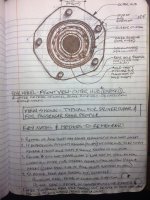D
Deleted member 21878
Guest
Guest
Offline
i was working on the aux fan today and noticed there is oil coming out of the LR wheel. i have pulled the wheel, drum and brake shoes (all wet with oil). since i replaced the o-ring on the hub assembly i assume the rear oil seal is leaking. some questions before i get started.
1) what size is the nut on the hub?
2) any trick to pull it off once i get it lose?
3) need to take out the wheel bearing (which seems good) any trick to getting the bearing and rear seal out?
4) any trick to getting it all back in?
5) also noticed i have some end play on the hub right now? normal and how much is normal?
6) think i can clean the oil out of the shoes? or best to just get new ones?
suggestions, links to videos or threads on same appreciated.
1) what size is the nut on the hub?
2) any trick to pull it off once i get it lose?
3) need to take out the wheel bearing (which seems good) any trick to getting the bearing and rear seal out?
4) any trick to getting it all back in?
5) also noticed i have some end play on the hub right now? normal and how much is normal?
6) think i can clean the oil out of the shoes? or best to just get new ones?
suggestions, links to videos or threads on same appreciated.

 Hi Guest!
Hi Guest!

 smilie in place of the real @
smilie in place of the real @
 Pretty Please - add it to our Events forum(s) and add to the calendar! >>
Pretty Please - add it to our Events forum(s) and add to the calendar! >> 


